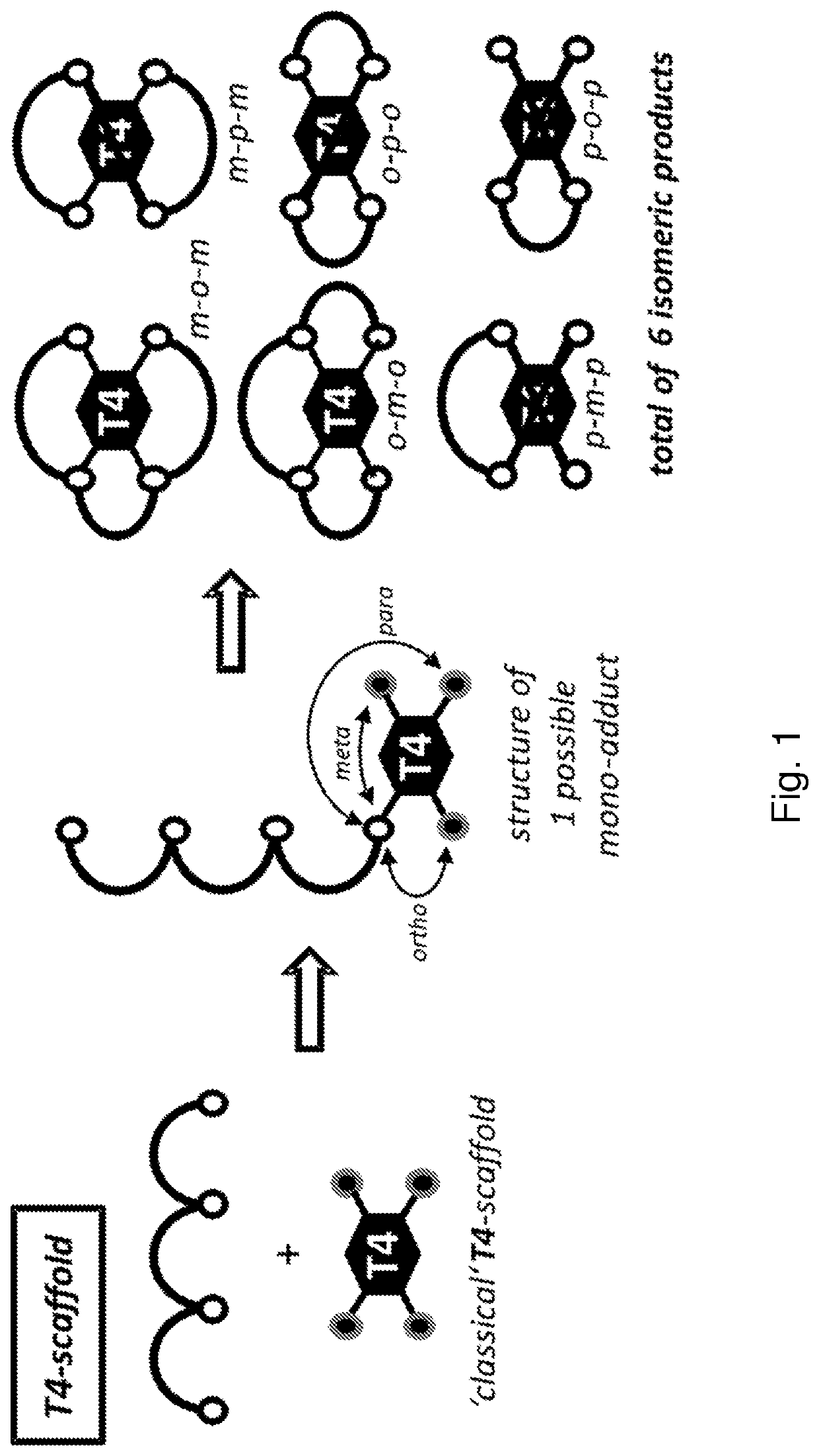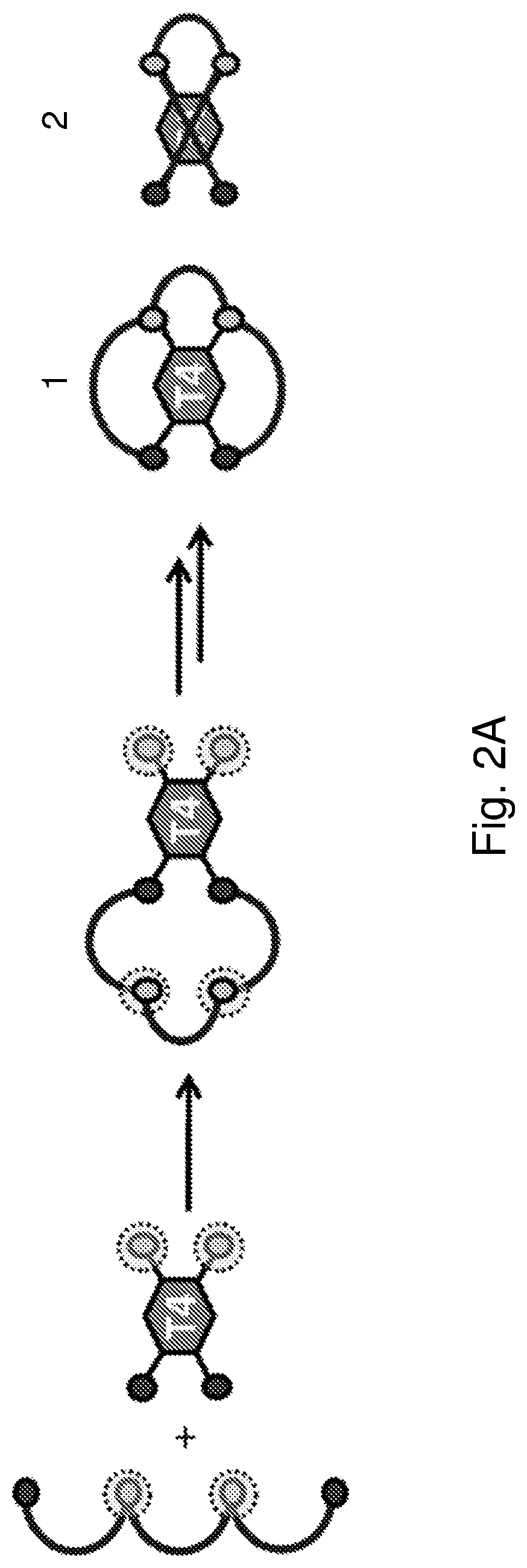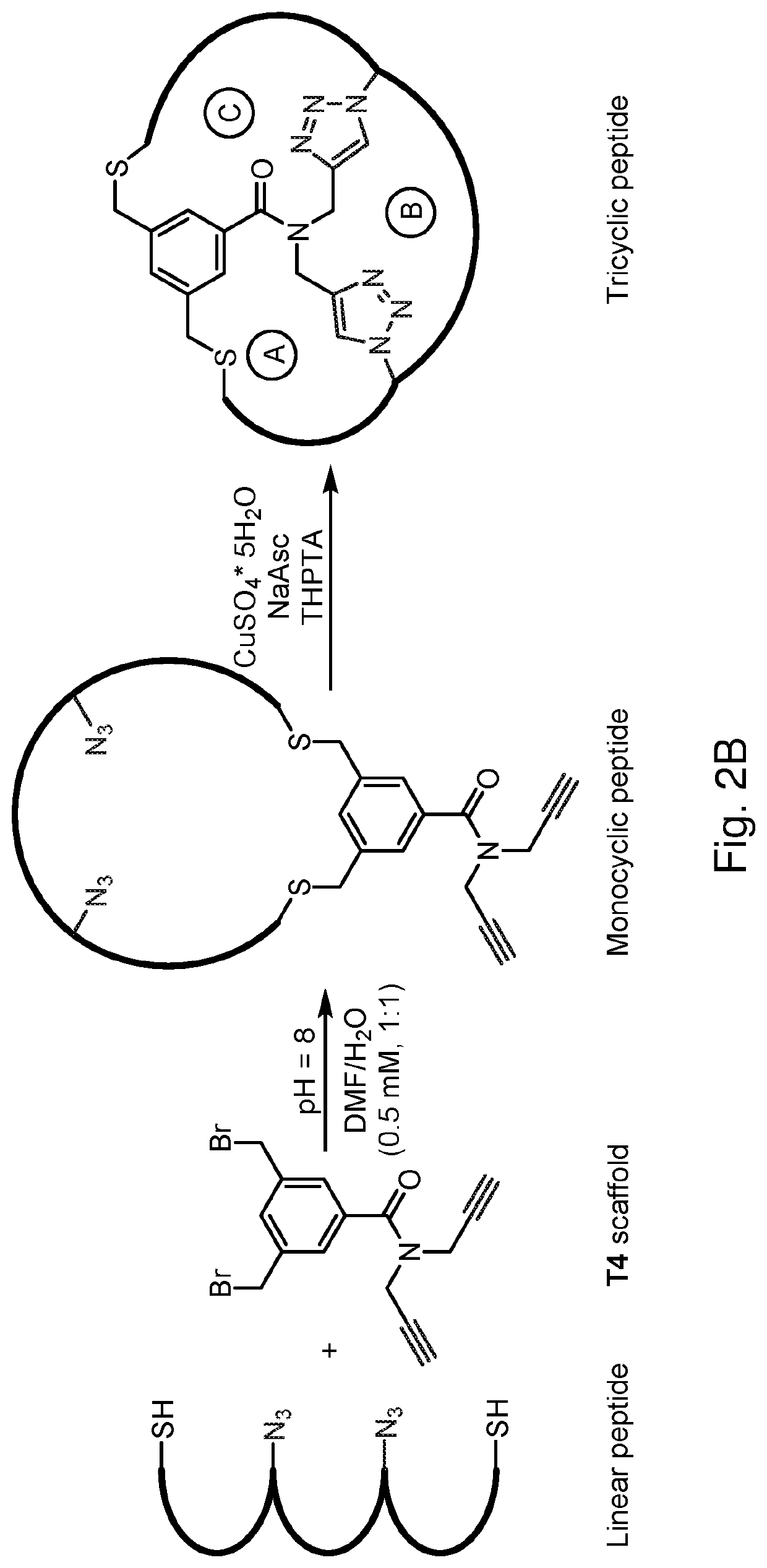Multicyclic peptides and methods for their preparation
a multi-cyclic peptide and peptide technology, applied in the field of proteinmimetics, can solve the problems of inability to routinely generate ‘antibody-like’ structural diversity, difficult to fine-tune binding affinities and/or selectivities, and laborious synthetic routes, and achieve the effect of increasing the structural diversity of scaffold-cyclized peptides
- Summary
- Abstract
- Description
- Claims
- Application Information
AI Technical Summary
Benefits of technology
Problems solved by technology
Method used
Image
Examples
example 1
of Peptide and Scaffold Via Thiolate Nucleophilic Substitution Reaction and Oxime Ligation
Amino Acids
Example of the Synthesis of a Phthalimide Protected Amino-Oxy Containing Amino Acid
[0227]
[0228]In a flame dried flask, under N2 flow, Fmoc-Asp-OtBu (100 g, 2.41 mmol) was dissolved in 15 ml freshly distilled THF. After cooling the mixture on ice, BH3.SMe2 (484 μL, 5.10 mmol, 2.1 equiv) was dropwise added. The mixture was warmed to rt. and stirred overnight, after which TLC showed full conversion of the starting material. The reaction mixture was quenched with saturated NH4Cl solution and extracted with EtOAc. The collected organic phases were washed with brine and dried over Na2SO4. The volatiles were removed under reduced pressure, yielding a colorless oil. Flash column chromatography (2:2:0.5—CH2Cl2:P.E.:EtOAc) yielded the homoserine-derived product as a colorless oil (833 mg, 2.10 mmol, 86%). 1H NMR (400 MHz, Chloroform-d) δ 7.79 (d, J=7.5 Hz, 2H), 7.62 (d, J=7.4 Hz, 2H), 7.43 (t,...
example a
lization with a Small Peptide
[0298]Peptide Ac—CE(pAcF)A(pAcF)KC—NH2 (1.10 mg, 1.13 μmol) was dissolved in 1 ml 3:2 DMF:H2O (1.13 mM). Scaffold T4N-3 (6.10 mg in 500 μl MeCN stock, used 65 μl, 0.8 equiv) was added followed by 50 μl of a 1M NH4HCO3 solution, to reach pH 8.5. FIG. 10 shows the LC-MS chromatogram after 30 min reaction time. At Rt 6.16 min, the UV trace is seen of the CLiPSed peptide, with m / z 1549.6 (calc 1549.6), corresponding to the [M+H]+ and 775.3 (calc 775.3) for the [M+2H]2+. At Rt 5.34 min, trace of the peptide-disulfide is seen.
[0299]The reaction mixture is acidified using 1 ml of 6M HCl solution, for Boc-deprotection. The reaction mixture is stirred at rt for 1 h, after which the pH is corrected to pH4 using 810 μl of a 5.5M NaOH (aq) solution. The reaction mixture was stirred overnight at rt. FIG. 11 shows the LC-MS chromatogram. At Rt 5.51 min, peak 1 is seen, and at Rt 5.71 min peak 2. Both 1 and 2 show similar mass spectra, which correspond to the 2×CLiPSed...
example b
lization with a Larger Peptide
[0300]Peptide Ac—CEK(pAcF)AS(pAcF)KDC—NH2 (1.30 mg, 0.99 μInca) was dissolved in 1 ml 3:2 DMF:H2O (1.13 mM). Scaffold T4N-3 (6.10 mg in 500 μl MeCN stock, used 57 μl, 0.7 equiv) was added followed by 50 μl of a 1M NH4HCO3 solution, to reach pH 8.5. FIG. 12 shows the LC-MS chromatogram after 30 min reaction time. At Rt 5.66 min, the UV trace is seen of the CLiPSed peptide, with m / z 1880.8 (calc 1879.8), corresponding to the [M+H]+ and 940.7 (calc 940.4) for the [M+2H]2+. At Rt 4.92 min, trace of the peptide-disulfide is seen.
[0301]The reaction mixture is acidified using 1 ml of 6M HCl solution, for Boc-deprotection. The reaction mixture is stirred at rt for 1 h, after which the pH is corrected to pH4 using 790 μl of a 5.5M NaOH (aq) solution. The reaction mixture was stirred overnight at rt. FIG. 13 shows the LC-MS chromatogram. At Rt 5.31 min peak 1 is seen, and at Rt 5.03-5.20 min 3 small peaks close together are shown, as part of 2. Both 1 and 2 show ...
PUM
 Login to View More
Login to View More Abstract
Description
Claims
Application Information
 Login to View More
Login to View More - R&D
- Intellectual Property
- Life Sciences
- Materials
- Tech Scout
- Unparalleled Data Quality
- Higher Quality Content
- 60% Fewer Hallucinations
Browse by: Latest US Patents, China's latest patents, Technical Efficacy Thesaurus, Application Domain, Technology Topic, Popular Technical Reports.
© 2025 PatSnap. All rights reserved.Legal|Privacy policy|Modern Slavery Act Transparency Statement|Sitemap|About US| Contact US: help@patsnap.com



